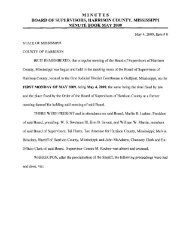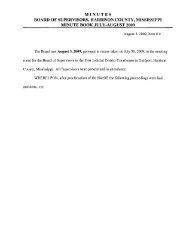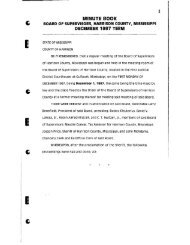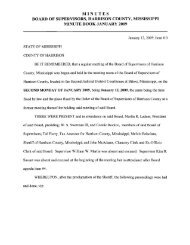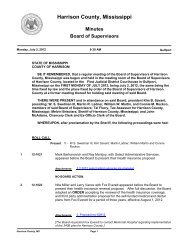minutes board of supervisors, harrison county, mississippi minute
minutes board of supervisors, harrison county, mississippi minute
minutes board of supervisors, harrison county, mississippi minute
Create successful ePaper yourself
Turn your PDF publications into a flip-book with our unique Google optimized e-Paper software.
existing and predictable hazardous conditions and has the authority to take<br />
prompt corrective measures to eliminate the hazardous conditions<br />
b.) Inspections may be needed throughout the shift and must be conducted<br />
after every rainstorm and after any other event that increases the risk <strong>of</strong><br />
hazardous conditions (e.g., possible cave-ins, indications <strong>of</strong> failure <strong>of</strong><br />
protective systems, hazardous atmospheres, or other hazardous conditions)<br />
if employees will enter the trench/excavation<br />
c.) Have a competent person classify soil types visually and use at least one<br />
manual method (plasticity, dry strength, thumb penetration); soils may be<br />
categorized into 3 groups other than solid rock:<br />
• Soil type A is the most stable; it included clay, silty clay, and hardpan; no type<br />
a soils can be fissured, subject to vibration, have been preViously disturbed,<br />
or be seeping water<br />
• Soil type B is <strong>of</strong> medium stability; it includes silt, sandy loam, s<strong>of</strong>t clay,<br />
submerged soil, and dense heavy unstable rock; it also includes non-type C<br />
soils that have previously been disturbed and type A soils that are fissured<br />
and subject to vibration<br />
• Soil type C is the least stable soil type; it includes gravel, loamy sand, s<strong>of</strong>t<br />
clay, submerged soil, unstable rock, and soil from which water is freely<br />
flowing.<br />
d.) Adequately slope or bench the sides, or use an appropriate protective<br />
system (shield, trench box, shoringlhydraulic shoring) based on the soil<br />
type<br />
e.) Sloping and Benching for trenches less than 20 feet in depth: For Type A<br />
soils, trenches must be slopedlbenched at 53 degrees or less (0.75<br />
horizontal feet for each vertical foot) unless the excavation will only be open<br />
for 24 hours or less and is less than 12 feet in depth. In t his case the trench<br />
may be sloped at 63 degrees or less (0.5 horizontal feet for each vertical<br />
foot). For Type B soils, trenches must be sloped/benched at 45 degrees or<br />
less (1 horizontal foot for each vertical foot). For Type C soils, trenches<br />
must be sloped/benched at 34 degrees or less (1.5 horizontal feet for each<br />
vertical foot)<br />
f.) Sloping and benching for excavations greater than 20feet in depth; In this<br />
case, sloping/benching must be designed by a registered pr<strong>of</strong>essional<br />
engineer.<br />
g.) for Protective systems: Protective systems must have the capacity to resist,<br />
without failure, all loads that are expected to be applied<br />
h.) Store all materials, including those removed from the trench or excavation,<br />
at least 2 feet away from the sides <strong>of</strong> the trench or behind a suitable<br />
restraining system<br />
L) Ensure that all adjacent buildings/structures or surface obstructions (e.g.,<br />
trees, large rocks) near the trench are supported or removed<br />
j.) Support and protect all utilities spanning a trench or excavation<br />
k.) Provide a fixed means <strong>of</strong> egress for trenches 4 feet or greater in depth;<br />
ensure individuals do not need to travel more than 25 feet to the closest<br />
means <strong>of</strong> egress<br />
I.) do not allow response and recovery workers to work in trenches or<br />
excavations where water has accumulated or is accumulating unless





